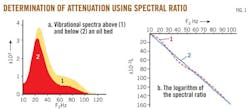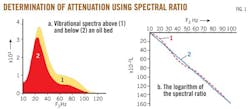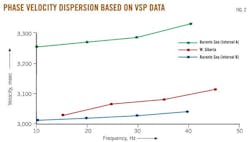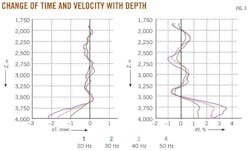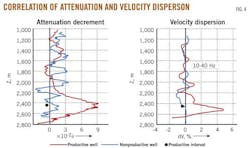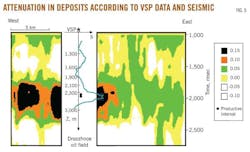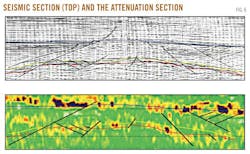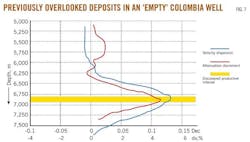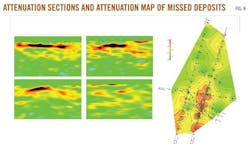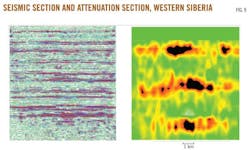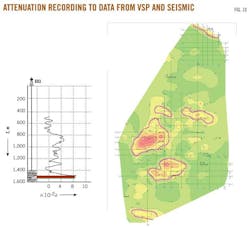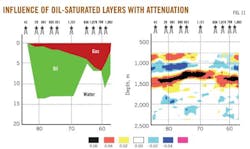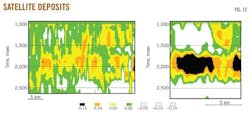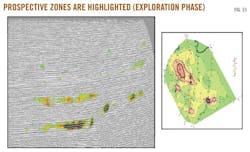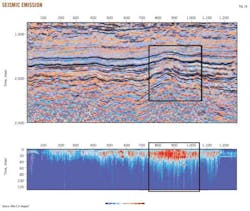Useful data lurk in seismic inelasticity, nonlinearity
Miron Rapoport
Geophysicist
Redmond, Wash.
Measurements of productive and dry wells, when correlated with actual processed seismic data from many fields, have shown that oil and gas deposits have both increased attenuation and dispersion of the phase velocity of longitudinal waves.
These are due to the thermodynamic instability of complex hydrocarbon mixtures as well as to phase transitions in such mixtures during propagation of elastic waves. These effects are characteristic nonlinear properties that can be used at various stages of the analysis of hydrocarbon deposits.
In oil and gas exploration, the main and often only method of subsurface imaging is conventional reflection seismic, which faces a number of limitations. Hydrocarbon deposits are weakly contrasting objects in seismic imaging and so are not usually visible. In a layered medium, boundaries between layers are more strongly contrasting, so seismic surveys are used to study their tectonics. This means seismic prospecting can be used to detect traps (i.e. porous layers which capture rising oil and gas, which are lighter than water).
Unfortunately, the only way to determine which fluids fill a trap has been to drill a well into it. In addition, in nonlayered environments (e.g., in the crystalline basement, which is often rich in oil and gas), traditional seismic prospecting for traps cannot be used at all.
However, using a more detailed analysis of conventionally collected seismic data, there is the possibility of immediate detection of hydrocarbon deposits—a methodology called "Direct Detection."1
Attenuation of seismic waves
In the 1950s, I.G. Medovsky demonstrated a new approach to the interpretation of petroleum geophysical data: methods of Direct Detection.
Medovsky discovered a seismic indicator of oil deposits: "blind" zones, i.e. the absence of reflective areas as a result of the attenuation of vibrations. At that time, seismic data were presented in the form of sections constructed by hand using oscillographically recorded vibrations.
Later, with the transition to digital recording of vibrations and computer processing, blind spots on the sections were rarely observed, which led some geophysicists to doubt the phenomenon of increased attenuation of vibrations in oil deposits. This necessitated experimental research of attenuation by hydrocarbons. The following are examples of processing of real data, illustrating the new capabilities of seismic prospecting using Direct Detection (most images obtained by V.I. Ryzhkov).
For the study of attenuation in deposits, we chose VSP data in productive and dry wells. Attenuation was determined by the first wave using the spectral ratio method (Fig. 1). The frequency dependence of the attenuation was almost linear.
Approximately 40 wells, mostly productive, were studied. In a linear medium, the principle of causality applies, so the presence of attenuation leads to phase velocity dispersion, i.e., its dependence on frequency. (These parameters are connected by a pair of Hilbert transforms.)
In the case of nonlinearity, the relationship becomes more complicated, but does not disappear. Therefore, we also studied velocity dispersion using the same VSP data, determining the velocity of the first wave in a number of narrow-band filterings. The velocity dependence on frequency is practically linear (Fig. 2).
In the studied wells, intense anomalies were observed in both attenuation and dispersion velocity at the depths of both oil and gas (Fig. 4). The actual values were probably even higher, because these measurements were smoothed by intervals, averaged over layers much thicker than the hydrocarbon deposits themselves.
To emphasize the unexpectedly large values of these measured parameters, we prefer to talk not about imperfect elasticity but rather about the innate inelasticity of oil and gas. But speaking of terms: In the literature, instead of absorption, authors often write about attenuation of vibration, and for quantitative description they use a reciprocal value—seismic quality factor. We consider both terms unfortunate.
Attenuation should also include other reasons for change of the amplitude of the wave during its propagation. Quality factor, a term borrowed from resonator theory, produces experimental values that don't smooth very well because of their non-Gaussianity. (Throughout this article, we use the term "attenuation" instead of "absorption," to follow the convention.)
The measurement error of these data can be estimated by values obtained in nonproductive intervals of the empty wells (Fig. 4). The margin of error is large: For the decrement of attenuation it is on the order of 0.01, and for the velocity dispersion it is on the order of 1%. But anomalous values in productive reservoirs are several times larger than this noise. Both attenuation and velocity dispersion produce anomalies, thus reliably indicating productive layers. This pattern was observed in all the studied wells without exception.
Analysis of seismic data
For practical purposes, it is crucial to be able to analyze the seismic data.
In this case, we also determined the attenuation using the method of spectral ratios, estimating the spectra in large time intervals (of course, using a different scheme of averaging), and estimating the dispersion by analysis of velocities of CDP on a number of narrow-band filterings. These data were compared with data on productivity in drilled wells. In Fig. 5, we compare the attenuation data from a seismic profile and from a well situated on it.
Fig. 6 shows the results for a large offshore structure. The central dome chosen by classic seismic was found to be "empty" upon drilling. From the attenuation section it can be seen that increased attenuation is absent at the central drill location but occurs at relatively shallow depths on the wings. These results have not been confirmed by drilling due to its high cost and prevalence of gas at the depths of these anomalies.
An interesting case is shown in Fig. 7.
At one location, we reprocessed seismic data of an "empty" well, finding strong anomalies of both parameters but far above the productive strata situated at the bottom of the well. When the well was reopened at the level of the anomaly, it yielded a commercial flow of oil. Thus by using Direct Detection, we managed to find a new reservoir in an oil field previously thought exhausted (Fig. 8).
Because of the necessity of smoothing the measurements, the vertical resolution is low, but it is sufficient to allow for studying of multistory deposits (Fig. 9).
The investigation of deposits based on attenuation and velocity dispersion is helpful at various stages throughout exploration and exploitation. Using it at the exploration stage significantly reduces the number of wells drilled and time used compared to conventional methods. Fig. 10 shows the results for a small field under exploration.
Above a thin layer of oil lie 600 m of gas saturated strata, in which the attenuation is much lower than in oil. A map of the oil reservoir shows the dimensions of the deposit and allows for optimal placement of wells.
During the exploitation stage, the ability to study the oil-saturated layers is important. During the flooding of a layer, one can see reduction in its volume. This allows for control of oil withdrawal and water injection (Fig. 11). Monitoring of reservoirs during their development is a promising area of application for the effect of seismic inelasticity. Seismic amplitudes are known to have been used for this purpose; however, the value of attenuation allows us to determine the contour of the deposit much faster.2
As deposits are depleted, it is necessary to replenish by commissioning missed satellite deposits. Fig. 12 (right) shows an unstructured deposit, subsequently confirmed by drilling, next to a large deposit, an edge of which is visible in the section on the left.
At the exploration stage, this method allows for selection of the most promising drilling sites, regardless of the structure of the trap and reservoir. An example of an anomaly found during the exploration stage is shown on Fig. 13.
Seismic inelasticity can be caused not only by hydrocarbons. We faced this when we had an anomaly that was confidently interpreted as a deposit but produced a fountain of water bubbling with carbon dioxide. This happened in an area of Caucasus well known for its mineral waters and was perhaps more valuable than a discovery of oil and gas deposits.
Cause of seismic inelasticity
The bibliography on seismic attenuation is very extensive.
Most frequently, the reason for dissipation of energy of seismic vibrations in porous media is attributed to the viscous friction of fluid on pore walls during seismic wave propagation (the theory of Frenkel-Bio-Nikolayevsky). According to this theory, the above results might be explained by the differences in the viscosity of oil, gas and water.
Contrary to this theory however, the largest differences are experimentally observed at the surface, decrease with depth, and can even change sign.3 In addition, the calculated values of attenuation and dispersion are much lower than the measured values shown above.
One should also take into account the specific properties of hydrocarbons and some other fluids. The phenomenon of gas-condensate fields is well known, such as giant Astrakhan field and many others. Initially, with high reservoir pressure, fluid is in the gas phase, but as the field is developed and the pressure drops, paradoxically, the liquid phase (gas condensate) forms, creating major problems for gas workers. Such phase transitions are characteristic of complex hydrocarbon mixtures. The latter tend to be thermodynamically unstable, and phase transitions in them may be triggered by very weak mechanical influences.
Mass transfer during phase transitions can be also caused by weak seismic influences, leading to loss of energy of vibrations, i.e. their attenuation.3 The effect of seismic influence on hydrocarbon deposits has been recently used in practice, leading to a number of interesting phenomena.4 Among them we will mention seismic emission4 5 6, i.e. generation of random vibrations (microseisms) by deposits, which can be used for detection of the deposits (Fig. 14).
Unfortunately, seismic emission cannot separate the effect of multiple deposits situated at different depths, i.e. it does not have vertical resolution, but may be useful in conjunction with other geophysical studies. Its advantage is the ability to study the crystalline basement and adjacent layers of sediments, as well as other unlayered media.
Another notable related effect is the observed increase of oil inflow and reduction of water content as a result of exposure to seismic waves.4 This technique has been successfully used to extend the lifespan of exhausted oil deposits.
The effects we are considering here (attenuation, velocity dispersion, emission, and alterations of oil inflow and water content) are all nonlinear functions of amplitude. Mass exchange during phase transitions takes time, so it can only be caused by low-frequency seismic vibrations. Indeed, increased inelasticity of deposits is not observed in acoustic logging for longitudinal waves due to the higher frequency of logging.2
The previously mentioned case of carbonated water also fits into this mechanism of attenuation: Carbon dioxide is either in the form of bubbles, or in solution, and changes from one state to the other and back again under the influence of seismic vibrations.
Last but not least, we can expect the same effect in gas hydrate deposits, which are becoming increasingly important. Gas hydrates are thermodynamically unstable as well, and seismic wave propagation should cause them to decompose into gas and water and back into gas hydrate during each cycle of vibration. Unfortunately, we were unable to obtain seismic records for gas hydrate deposits, which would have allowed us to experimentally study their inelasticity.
Thus, our theoretical explanation of the observed effect of seismic inelasticity is nonlinear phase transition phenomena in hydrocarbon reservoirs. The use of this effect during various stages of oil and gas exploration and exploitation opens new, previously unknown opportunities for studying oil and gas deposits.
In conclusion, we will note that the above research has only studied the interaction of oil and gas deposits with longitudinal elastic waves, as observed in VSP and seismic prospecting. Research on low frequency transverse waves would be of great scientific and practical interest, as would research on the effect of oil and gas deposits on the high frequency vibrations of longitudinal and transverse waves in acoustic logging.
References
1. Rapoport, M.B, Rapoport, L.I., and Ryzhkov, V.I., "Direct detection of oil and gas fields based on seismic inelasticity effect," The Leading Edge, March 2004.
2. Ryzhkov, V.I., "Method for detecting oil and gas using their imperfect elasticity, based on the combined analysis of surface and well data," State Oil and Gas Univ., Moscow, 2008.
3. Rapoport, L.I., "Influence of the critical state of hydrocarbons on attenuation and velocity of seismic waves," in "The search and exploration of oil and gas deposits using geophysical methods," M. Ming, 1986.
4. Nikolaev, A.V., "Problems of nonlinear seismic," in "Problems of nonlinear seismic," M. Science, 1987.
5. Arutyugov, S.L., Kuznetsov, O.L., and Vostrov, N.N., et al., "ANCHAR technology is 10 years old," Seismic Technology, No. 2, 2004.
6. Hogoev, E.A., "Forecast of petroleum potential and recommendations for exploration drilling based on microseismic analysis," Institute of Petroleum Geology and Geophysics.
The author
Miron B. Rapoport ([email protected]) is a doctor of science, professor, and active member of the Russian Academy of Natural Sciences. He has been a geophysicist in Russia for nearly 60 years. His most recent scientific work has been on the attenuation and velocity dispersion (AVD) method, which is based on the seismic inelasticity effect of hydrocarbon deposits. The method has been used with success in the North Caucasus, Western and Eastern Siberia, Komi Republic, China, Colombia, offshore Viet Nam, and in other regions. Rapoport graduated from Politecnica Lvov as a geophysicist in 1954 and completed advanced studies in geophysics at Petroleum Institute Moscow.
